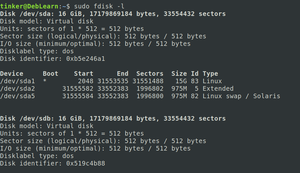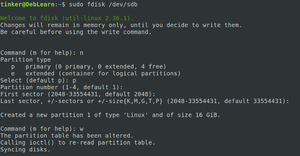Adding a new drive from the command line
Jump to navigation
Jump to search
| 11 (bullseye) |
|-
| style="text-align: center; width: 60px;" colspan="3" | A little note about typographic conventions you'll see here
|}
Connect the drive
Either plug the drive into the machine with the power off or hot-swap it in if possible...
(Yes... Adding a new drive to an ESXi VM is just like hot-swapping.)
Determine the device
sudo fdisk -l
fdisk is a dialog-driven program for creation and manipulation of partition tables.
man fdisk- for details...
You'll see a fair bit of output.
- Blocks starting with Disk /dev/sd_: indicate drives and provide details about them.
- Blocks starting with Device Boot Start... indicate partitions on those drives.
- In the case of an unformatted new drive, you'll see a Disk block that's not followed by a Device block. Make note of it's name (/dev/sd_)
- In our example, it's /dev/sdb
Partition the drive
For now, we'll just make the new drive one partition.
sudo fdisk /dev/sdbn- To create a new partition
p- To make it a primary partition
- Hit
Enter- 3 times to pick the default values.
w- To write the partition table to the drive.
Format the drive
Of course, the drive needs to be formatted before you can use it.
We'll go with Ext4 for now.
sudo mkfs.ext4 /dev/sdb1
A Little Note: You can actually format the whole drive without partitioning it.
Mount the drive
Create a mount point for the drive:
sudo mkdir /MOUNTPOINT
& mount it for use:
sudo mount /dev/sdb1 /MOUNTPOINT
Make the mounting automatic
sudo vi /etc/fstab
& add the line:
/dev/sdb1 /MOUNTPOINT ext4 defaults 0 0



